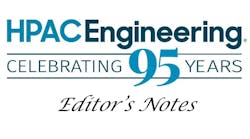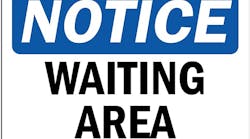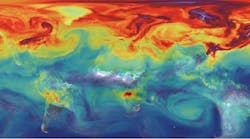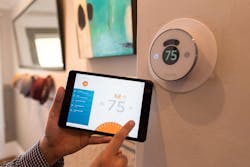This month marks five years since I began writing Clark’s Remarks for HPAC Engineering.
During that time, in addition to purely HVAC issues, I have touched on topics as diverse as biofuels and bugs. There have also been several articles about more controversial subjects, such as climate change, sea level rise, and our environmental professional responsibility, and I have received my share of opposing viewpoints. It seems that HPAC Engineering readers are not noted for their shyness and reticence! What has been surprising to me, however, are the number of engineers and other well-educated HVAC professionals who continue to refuse to accept the science of climate change.
Perhaps even more surprising than the climate change deniers has been the resistance that I have encountered with many of my clients when introduce them to new technologies. In many instances, they are averse to even considering those technologies, all of which could save them real money! Over the past eight years of my consulting practice, I have learned that facility owners and managers are generally not early adopters.
One common example is the many commercial building owners/managers who are still reluctant to implement smart HVAC technology. For instance, even relatively simple wireless thermostats, which allow temperatures in multiple zones to be remotely monitored and controlled, can be off-putting to some owners because of the perception that they are just “too expensive”. As a rookie energy auditor, I was taught that it’s very difficult to quantify avoided energy consumption due to controls, from smart thermostats to complex building automation systems (BAS). That is less true today, since even those simple smart thermostats can provide significant, demonstrable energy savings.
Even well-established technologies, such as ice-based thermal energy storage (TES), are a hard sell without significant utility incentive/rebates. Although FPL – our local utility – rebates for TES are relatively generous, when they dropped the financial incentive for having a feasibility study performed, inquiries to engineering firms, ours included, declined almost immediately. But there is no doubt that, in the right application, TES saves money.
Much of owners’ and managers’ reluctance to adopt these technologies is, obviously, their concern that they won’t really be cost-effective. And with all of the fads, it can be sometimes difficult to discern the legitimate innovations from the scams. Which is why one of the important things that I have learned since becoming a consultant is that our role is as much teacher as practitioner. Educating our clients and prospects as to which technologies actually make sense for them is a critical element of our work. Writing this column for the past five years has provided me with a pulpit to reach not only my clients, but many others in our industry, as well. And that's an opportunity for which I am truly grateful. But our work is never finished, and we can always learn more. So if you have any suggestions for future topics, please let me know at [email protected].
A regular contributor to HPAC Engineering and a member of its editorial advisory board, the author is a principal at Sustainable Performance Solutions LLC, a south Florida-based engineering firm focusing on energy and sustainability.










